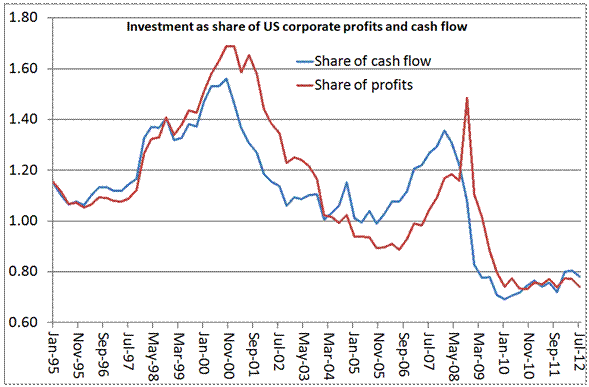Just a short one on US growth now that the Q3’12 real GDP data revision has been released. Third quarter annualised real GDP growth was revised up from 2% to 2.7%. That sounds good, but the devil is in the detail. It was only revised up because of an increased estimate of inventories or stocks of goods produced. In other words, US capitalists produced too much compared to demand and had to stock the excess. Final demand or sales was revised down and, most significant, non-residential investment (excluding the purchase of homes) growth was taken down substantially.
This is last figure is the best measure of new investment by the capitalist sector in an economy and it does not look good. Real investment is still some 8% below the peak before the Great Recession. Investment had fallen 24% from its peak in Q3’07 to mid-2009. Then it recovered but is now slipping back again.
And the indicators for investment over the next few quarters are not good either. One good indicator of where investment is going is to look at ‘core’ capital goods orders (excluding aircraft and defence). That is moving into recession territory, although it is probably too early to judge. The figure is from the Doug Short site.
And yet corporate profits are still rising, at least when measured by the rather artificial methods of the US Bureau of Economic Analysis of corporate profits (after inventory and capital consumption adjustment). If we take a ‘purer’ figure of net cash flow for US businesses (before they pay tax, interest, dividends and make room for depreciation) it is not quite so rosy.
Indeed, the gap between available profits and investment by the US capitalist sector has never been greater. US capitalists are on an investment strike, still not convinced that profitability is sufficient to launch into new investment.
And contrary to the views of the underconsumptionists, household consumption in the US as a share of GDP is only just off its all-time high, at 70.5%. And yet investment to GDP is just 14% of GDP, no higher than it was in the mid-1990s. The Great Recession was a product of collapse in capitalist investment and the property market, not a collapse in household spending.
So we remain in what I call a Long Depression. This is best shown in my last graph. The gap between trend average real GDP growth per head of population prior to the slump and actual growth opened up during the Great Recession. But unlike previous recessions, that gap has not been bridged in the recovery. Indeed, the gap is still widening on a per capita basis. We are in unprecedented times at least since the Great Depression of the 1930s.






Reblogged this on exval and commented:
Michael Roberts as always putting the present crisis in perspective.
Interesting that the ratio of investment to profits is a mere 1% – more or less annihilates any argument that profits are necessary as a source of investment, as I’m sure you’ve pointed out before. In other words you could (using political pressure) transfer 90% of profits to the public sphere, and still have room to increase private investment by 9% points. The only sufferer being luxury spending by the capitalists.
Amazing that a completely sterile tax on everyone (profit) for the sole benefit of people who happen to own capital can be extorted all day every day worldwide and never be described as such.
Regarding the 1st graph, are you sure you can say it is slipping back again? There is also a small dip in 01/10/2010 and 01/01/2011.
Investment as a % of corporate profits and cash flow (graph 4) speaks volumes. As we ought to know, nothing says “recession, no recovery in sight” like this ratio. Thanks Michael.
Interesting charts, thanks michael